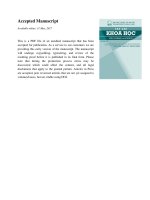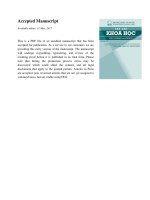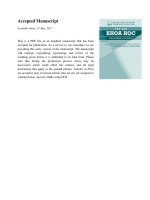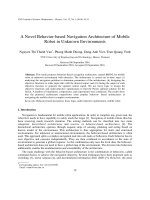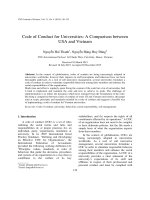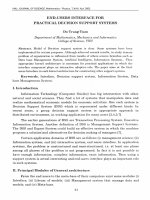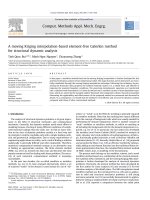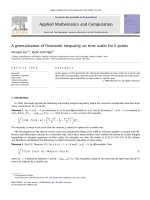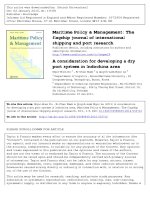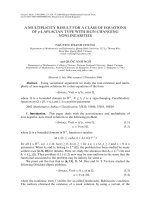DSpace at VNU: A novel platform for internet-based mobile robot systems
Bạn đang xem bản rút gọn của tài liệu. Xem và tải ngay bản đầy đủ của tài liệu tại đây (718.83 KB, 6 trang )
A Novel Platform for Internet-based Mobile Robot
Systems
P. M. Duong, T. T. Hoang, N. T. T. Van, D. A. Viet and T. Q. Vinh
Department of Electronics and Computer Engineering
University of Engineering and Technology
Vietnam National University, Hanoi
Abstract—In this paper, we introduce a software and hardware
structure for on-line mobile robotic systems. The hardware
mainly consists of a Multi-Sensor Smart Robot connected to the
Internet through 3G mobile network. The system employs a
client-server software architecture in which the exchanged data
between the client and the server is transmitted through different
transport protocols. Autonomous mechanisms such as obstacle
avoidance and safe-point achievement are implemented to ensure
the robot safety. This architecture is put into operation on the
real Internet and the preliminary result is promising. By
adopting this structure, it will be very easy to construct an
experimental platform for the research on diverse teleoperation
topics such as remote control algorithms, interface designs,
network protocols and applications etc.
limit the system from future developments in which the realtime attribute is highly demanded. In addition, the lack of
autonomous mechanisms may influence the robot safety and
downgrade the system performance in case of network
congestion or interruption.
Keywords- Telerobot; internet robot; distributed control; robot
navigation; networked robot; robot platform
On a similar note, Dawei et al proposed a quite complete
online robot platform in which an Omni-directional mobile
robot with a five DOFs arm is controlled over the Internet by
using a virtual represent [9]. During the control session, virtual
environment of the remote site is continuously updated at the
local site and the next position of the robot is predicted and
pointed out in the virtual environment. This combined with a
visual feedback display enables user to effortlessly navigate the
mobile robot in an unknown environment. In addition, the
robot safety is strictly ensured by build-in autonomous
mechanisms. The use of sonar sensors with a measuring range
of 4cm to 400cm for building the virtual environment,
however, may limit the applicability of the system to indoor
applications only.
I.
INTRODUCTION
Seventeen years after the first system appeared in 1994 [3],
Internet-based telerobot has made a great contribution to the
modern life allowing us to remotely visit museums, tend
gardens, navigate undersea, float in blimps, or handle protein
crystals[1]–[5]. Whereas early researches tried to answer the
question of how to control a robot through the Internet
[3][6][7], recent studies have focused on how to control it in
real time and deal with the inevitable Internet transmission
delay, delay jitter and non-guaranteed bandwidth, etc [8]-[10].
To be effective, a research project may focus on only one
single specific aspect and a common experimental platform is
usually desirable for the purpose of implemental verification;
however, significant work will be needed to build an
experimental platform from scratch. Several Internet-based
robot platforms therefore have been proposed with their
strengths and limitations [9][11][12].
In [11], a web-based telerobot framework is developed in
which communications between users and the robot are
centered around a web server. The system consists of four
modules: a commercial Pioneer mobile robot, a visual feedback
display, a global environment map and a web interface,
communicated over TCP protocol. By using the web interface,
users are able to control the robot over the Internet to explore a
laboratory or to push a ball into a goal. The use of TCP which
was originally designed for the reliable transmission of static
data such as e-mails and files over low-bandwidth, high-errorrate networks as the communication protocol, however, may
978-1-4577-2119-9/12/$26.00 c 2011 IEEE
A more flexible and extensible approach is to use clientserver architecture as described in [12]. This modular structure
allows users to quickly construct further developments of
Internet mobile robot. The system uses UDP as the transport
protocol and includes essential modules for an Internet robot
system such as a mobile robot, a visual feedback display, a
virtual environment display and a user-friendly graphic user
interface.
In this paper, we propose a novel platform for Internetbased mobile robot systems with improvements in hardware
configuration and software development. The system is in
Client-Server mode, which contains users, as the command
input and the Multi-Sensor Smart Robot (MSSR), as the
controlled plant. The MSSR has accurate motion control with
PID algorithm and contains many types of sensors to support
diverse purposes of development. The MSSR is connected to
the Internet via 3G mobile network. Autonomous mechanisms
including obstacle avoidance and safe-point achievement are
implemented in the robot. The software has two main modules:
a client controller at the user site and a server module at the
robot site. A multi-protocol model is applied to deliver the data
exchanged between the client and server. The platform is
implemented on the real Internet and the experimental result is
promising. By adopting this, it will be very easy to construct an
experimental system for the research on diverse teleoperation
1972
topics such as remote control algorithms, interface designs,
network protocols and applications etc.
The paper is organized as follows. Details of the hardware
configuration is described in Section II. The software
development is described in Section III. Section IV introduces
experiments in the real Internet environment. The paper
concludes with an evaluation of the system, with respect to its
strengths and weaknesses, and with suggestions of possible
future developments.
II.
HARDWARE DESIGN
In order to be a platform for different developments, the
system hardware needs to be designed to support not only a
specific task but also a wide range of applications including
both indoor and outdoor environments. In our system, the
hardware design is split into three perspectives: the
communication configuration, the sensor and actuator, and the
user interaction; each is developed with the feasibility, the
flexibility and the extendibility in mind. Fig.1 shows an
overview of the system.
internal mobile SIM card is used. The USB is plugged into the
computer inside the robot and is registered to a mobile phone
service provider allowing it to have access to the Internet
(fig.1). This simple configuration enables the robot to connect
to the Internet without any restrictions in physical distance as
far as the 3G mobile signal is presented which is almost
everywhere in the country due to the fact that the 3G signal
already covers it all.
B. Sensors and Actuators
The sensors and actuators are included in a Multi-Sensor
Smart Robot (MSSR) developed by our laboratory. The scheme
in fig.3 describes sensors, actuators and communication
channels in the MSSR. It contains basic components for motion
control, sensing and navigation. These components are drive
motors for moving control, sonar ranging sensors for obstacle
avoidance, compass and GPS sensors for heading and global
positioning, and laser range finder (LMS) and visual sensor
(camera) for mapping and navigating.
Network
Interface
Camera
GPS
Module
Compass
Module
Figure 1. System hardware configuration
A. Communication configuration
To the best of our knowledge, most current Internet robot
systems use a common configuration for the network
connection in which the robot and components are connected to
the Internet through a central wireless access point (fig.2)
[9][11][12]. This configuration is easy to set up but it restricts
the operational area of robot and components to a radius of
several hundred meters due to the transmit power limitation of
the wireless access point. This range is acceptable for indoor
environment but is insufficient for outdoor applications such as
traffic control and disaster rescue.
PC
Frame
Grabber
USB
USB to
RS-232
MCU
dsPIC
30F4011
USB to
RS-485
USB
USB
USB
Sonar
Module
Trigger for
LMS
Trigger switch
PID
Controller
Laser Range
Finder (LMS)
USB to
RS-232
M0
Encoder
PID
Controller
M1
Encoder
PID
Controller
M2
Encoder
Figure 3. Sensors, actuators and communications in the MSSR
Figure 2. Network configuration of current Internet-based robot systems
In our system, instead of using a wireless access point, the
3G mobile network is utilized as the communicating bridge
between the robot and the Internet. A 3G USB device with an
The drive system uses high-speed, high-torque, reversibleDC motors. Each motor is attached a quadrature optical shaft
encoder that provides 500 ticks per revolution for precise
positioning and speed sensing. The motor control is
implemented in a microprocessor-based electronic circuit with
an embedded firmware which permits to control the motor by a
PID algorithm.
2012 7th IEEE Conference on Industrial Electronics and Applications (ICIEA)
1973
The positioning and heading modules contain a CMPS03
compass sensor and a HOLUX GPS UB-93 module [14][15].
The compass sensor has the good heading resolution of 0.1°.
The GPS with lower accuracy is used for positioning in
outdoor navigation. Due to the networking is available in our
system, an Assisted GPS (A-GPS) can be also used in order to
locate and utilize satellite information from the network in poor
signal conditions.
III.
The system software employs a client-server architecture
for robot control and feedback information display. A brief
functional software structure of the platform is shown in fig.4.
Client module
The MSSR provides eight SFR-05 ultrasonic sensors split
into four arrays, two on each, arranged at four sides of the
robot. The measuring range is from 0.04m to 4m.
1974
User’ commands
Transport protocols (RTP, TCP, UDP)
Communications
module
INTERNET
The visual system is detachable and mounted on the head of
the MSSR. It mainly consists of a Sony EVI-D100 pan-tiltzoom (PTZ) color camera and an EasyCap adapter, which is to
capture the video. The rotation ranges of the pan-tilt camera are
from -100 to +100 degrees in horizon, from -25 to +25 degrees
in vertical and are available to give the user a clear view of the
environment in front of the robot.
C. User interaction devices
The interaction devices at the user site simply consist of a
personal computer and a joystick. The computer is an ASUS
notebook computer with 1.5GHz M-Centrino processor,
500Mb RAM and Windows XP operating system. The
computer, with installed control software, allows users to
retrieve feedback information of the remote site and navigate
the robot to explore an unknown environment. To support users
with a more convenient way of control, a joystick is added. The
joystick is the 3D Logitech Extreme series with 10 bit
resolution in horizontal and vertical axes and 12 functioning
buttons. In the system, the joystick interprets users’ inputs to a
sequence of control parameters and forwards them to the
control software for processing.
GUI
Feedback data
On the front side of the robot, a 3D-image capturing system
is built based on a SICK-LMS 221 2D laser range finder
[13][22]. The system has the horizontal view angle of 100°
(angle resolutions are 0.25°, 0.5° and 1°) and the vertical
(pitching) view angle of 25°. The data produced by ultrasonic
sensors and laser range finder which covers a range from
0.04m to 80m is used to build global and local maps of the
robot’s operational environment.
The communication data between devices and the computer
in the robot is transferred via several channels: low-rate
channels with standards of RS-485 and RS-232 and high-rate
channels with USB ports. Devices using the RS-485 are
managed by an on-board 60MHz Microchip dsPIC30F4011based microcontroller with independent controller boards for a
versatile operating environment. A RS-485 bus is established to
maintain the communication between controllers and reserve
the expansibility to support various accessories. Devices using
the RS-232 are directly connected the USB-to-COM modules.
Commands of control and acquisition with short messages are
realized in low-rate channels. On the other side, images from
camera are captured by a frame grabber and directed to a highrate USB port. The communication between the remote-site
(robot) and client-site (user), as described previously, is
realized by computer network.
SOFTWARE DEVELOPMENT
Transport protocols (RTP, TCP, UDP)
Feedback data
User’ commands
Data processor
Central server
Low-level sensing
and actuator module
Fuzzy-based
controller
Figure 4. System software architecture
In the model, there are four modules: the communication
module, the central server, the fuzzy-based controller, and the
client module. Details of these modules are described as
follows.
A. Multi-protocol communications
Various types of information need to be exchanged between
the robot and the human operator. Generally, there are three
classes of data:
•
Administrative data (such as access control, user
validation, and configuration data) and user control
commands (such as desired translation velocity and
rotation angle): small packet size, non-periodic
transmission and requiring reliable delivery.
•
Image data (the most important and costly information
feedback): large packet size, periodic transmission,
real-time delivery is required, requires significant
2012 7th IEEE Conference on Industrial Electronics and Applications (ICIEA)
bandwidth, and the most recent information is
preferred should packets become lost.
•
Continuous control data (joystick signal) and feedback
information on the scene and the robot (such as
position of the robot and sensing data): small packet
size, periodic transmission, real-time delivery is
required, and the most recent information is preferred
should packets become lost.
From the above categorization, it is clear that all types of
information require real-time delivery except for once-for-all
administrative data and user control commands. Consequently,
to obtain the optimal performance, different transport protocols
should be used for the transmission of each information
category.
There are currently three main transport protocols available
for implementing remote control applications over the Internet:
the User Datagram Protocol (UDP) [16], the Transmission
Control Protocol (TCP) [17], and the Real-time Transport
Protocol (RTP) [18].
UDP is based on the idea of sending a datagram from a
device to another as fast as possible without due consideration
of the network state. This protocol does not maintain a
connection between the sender and the receiver, and it does not
guarantee that the transmitted data packets will reach the
destination as well as the chronological order of the data at the
receiving end. TCP is a more sophisticated protocol which was
originally designed for the reliable transmission of static data
such as e-mails and files over low-bandwidth, high-error-rate
networks. In each transmission session, TCP establishes a
virtual connection between the sender and receiver, performs
the acknowledgment of received data packets and implements
the retransmission mechanism when necessary. TCP can also
adapt to the variation of network condition by applying strict
congestion control policy with slow start, fast recovery, fast
retransmit and window-based flow control mechanisms. RTP is
the standard for delivering real-time multimedia data. The
protocol provides facility for jitter compensation and detection
of out-of-sequence arrival in data, and it is usually used in
conjunction with the RTP Control Protocol (RTCP). More
details of comparison between protocols is investigated in our
previous work [20].
From the above analysis, it is well recognized that RTP is
suitable for video streaming; UDP has advantages in sensing
data transmitting while TCP is the best in delivering
administrative data and user control commands. This
configuration is successfully implemented in our
communication module.
B.
Central Server
In the system, the server handles all control requests from
clients, processes them and forwards the translated data to the
MSSR. The control requests include the user operation and
autonomous movement. Users can control the remote robot by
sending primitive commands and using the arrow buttons in the
user interface. Users can also input commands by using a
joystick attached at client computer. After receiving the
commands, the robot moves towards corresponding direction
until the user pushes the stop button. During the movement, the
robot can exert local intelligence to avoid obstacles or to move
autonomously to a pre-defined safe point if a network
interruption event is detected. Dead reckoning and obstacle
avoidance algorithms are involved in the local intelligence of
the robot and handled by fuzzy logic-based controller.
For the feedback data, the server periodically retrieves
sensor information about status of the robot and transmits it to
clients. The sensor data includes the battery level, robot
position and speed, ultrasonic and laser ranges, compass
deflection angle and GPS longitude and latitude. The sensing
data is packetized as described in fig.5 and transmitted over
UDP protocol.
Total length
16 bits
Checksum
16 bits
Sensor data separated by “::” string
Figure 5. Packet format of data feedback at application level
In the system, the server program was written in Visual
C++ and the communication between the server and client was
established through socket, an abstraction that represents a
terminal for communication between processes across a
network.
C.
Fuzzy Logic Control
The objective of the fuzzy logic-based controller in our
system is twofold. Firstly, it adjusts parameters of the robot
during the process of user operation according to network
conditions; secondly, it navigates the mobile robot to avoid
obstacles and to reach a pre-defined safe point in case of a
network interruption. The implementation of the fuzzy logicbased controller is divided into three circumstances:
•
The fuzzy algorithm to adjust robot parameters
according to network conditions.
•
The fuzzy algorithm to avoid obstacles.
•
The fuzzy algorithm to find the safe point.
In each circumstance, the implementation of fuzzy
algorithm consists of four steps: defining the problem, defining
the linguistic variables and the membership functions, defining
the fuzzy rules and defuzzification. The details of fuzzy
algorithms implementation were described in our previous
paper [19].
D. Graphic User Interface (GUI)
The user interface is designed with the intention of making
it easy for users to interact with the mobile robot. Through the
GUI, users are able to observe the remote environment, access
the system parameters, and control the robot in real time over
the Internet. Fig.6 shows the designed GUI which is split into
four areas: the system parameters, the manual control, the
visual feedback display and the virtual represent.
The system parameters display information about the
current status of network and robot. The network status
includes the connecting state, the time delay and the delay
jitter. The robot parameters are the battery level, the robot
2012 7th IEEE Conference on Industrial Electronics and Applications (ICIEA)
1975
position and speed, the compass and GPS data, the sonar
ranging and the laser scanning data. This area also handles the
function of establishment and termination of network
connection.
MSSR was controlled from a distance of 20km to moving
outdoors around the university campus while avoiding several
static obstacles; the PTZ camera and the virtual represent was
used in this test.
The manual control displays functioning buttons for users
to input commands to control the mobile robot over the
Internet. A joystick is available to supply users with a more
intuitive and interactive control.
Figure 7. A sequence of images showing the motion of robot in a laboratory
environment during the tele-navigation operation
Figure 6. The graphic user interface
a) Virtual represent b) Visual feedback display
c) Manual control d) System parameters
The Visual feedback: The continuous and steady image
stream feedback from the robot site is necessary when the
Internet users control the mobile robot at the client site.
Moreover, the image quality should be good enough to provide
as much information about the remote site for teleoperation as
possible. In this paper, H.264 algorithm [21] is used to
compress the images before sending, and decompress them
after receiving. H.264 is a kind of video compression scheme
which supports video meeting application. It makes high grade
media stream transfer through the low bandwidth network. By
similar forms, the zoom and the angles of the PTZ camera can
be set via the Internet. The PTZ camera can help users have
more information about remote environment, especially for the
mobile robot.
The virtual represent is a module that works on the client to
handle the sensing data packets sent by the central server.
Based on the extracted data, the virtual world model draws an
arrow representing the robot position and direction as well as
the trajectory at the specific coordinate. An environment map is
built based on the sonar and laser readings, and be updated
every 100ms. With this virtual environment map, the user can
find suspected obstacles nearby, and make correct decision
when visual feedback suffers from serious time-delay or
obstacles beyond the camera’s scope.
IV.
EXPERIMENTS
During the project development, different configurations
were tested in different environments. The aim is to develop a
more reliable system framework that can be used in the real
world.
As shown in fig.7, the MSSR mobile robot was controlled
from a distance of 30km to explore the laboratory we are
working in; the PTZ camera was used. In another test, the
1976
Fig.8 shows the moving paths of the robot at the local site
and the simulated path at the remote site in this experiment.
Due to the network delay, there are slight differences between
two paths but the maximum errors of 0.09m in horizon and
0.07m in vertical are acceptable for the direct control.
Figure 8. Moving path of the robot at the local site (blue solid line) and the
simulated path at the remote site (red dashed line)
When the mobile robot moves at the low speed and few
obstacles block the path, the advantage of having direct control
is that the user can see the result of his/her own action without
any external contribution. However, the control of the robot is
more difficult in a complex environment under the high robot
speed and serious network transmission delay. Table I displays
time delay feature of the system network according to the
transmitting data size. Due to the size of the sensing feedback
data is around 500 bytes and the sampling period is 200ms, the
time interval between the moment that a feedback data packet
sent and the virtual represent begins to update is about 429ms.
In our system, the speed of robot is from 0m/s to 1.5m/s and
the time delay of the video stream is around 2000ms. A
scenario in which the speed of robot is 1m/s means that users
are impossible to recognize a sudden obstacle appeared in front
of the robot at a distance of 0.429m by the virtual represent and
at a distance 2m by the camera. The present of the autonomy is
necessary in this scenario to ensure the safety of the robot and
the success of navigation.
2012 7th IEEE Conference on Industrial Electronics and Applications (ICIEA)
TABLE I.
TIME DELAY OF THE NETWORK
REFERENCES
[1]
Time delay (ms)
Data Size
(byte)
Minimum
Average
Maximum
100
79
103
189
500
99
129
229
1000
109
140
229
2000
149
255
410
[2]
[3]
[4]
[5]
[6]
[7]
[8]
[9]
b)
a)
Figure 9. Moving paths of the robot in autonomous mode
a) obstacle avoidance b) Safe-point achievement
[10]
Fig.9a shows the experiment in which the robot himself
successfully avoids the obstacle Or during a teleoperation. The
situation of network interruption is investigated in a different
experiment in which the operator suddenly disconnects the
Internet connection at point Oi of a tele-guidance process. The
robot continues to move for 5s to point Oe before it detects the
interruption event, activates the autonomous mode and
automatically navigates to the safe point Od (fig.9b).
V.
CONCLUSION
It is extremely time-consuming to build an experimental
platform for the study of Internet robots from scratch. In this
paper, a new modular platform for Internet mobile robotic
systems is developed. The system hardware mainly consists of
a Multi-Sensor Smart Robot. Many types of sensors including
position speed encoders, integrated sonar ranging sensors,
compass and laser finder sensors, the global positioning system
(GPS) and the visual system are implemented allowing the
robot to support a wide range of applications including both
indoor and outdoor environment. The limitation in working
area is removed by the use of 3G mobile network. The system
employs a client-server software architecture for robot control
and feedback information display. The exchanged data between
the client and server is transmitted over the Internet by a multiprotocol model. Autonomous mechanisms based on fuzzy logic
algorithms are implemented to ensure the robot safety. The
platform has been tested in different environments, and the
results are promising.
ACKNOWLEDGMENT
[11]
[12]
[13]
[14]
[15]
[16]
[17]
[18]
[19]
[20]
[21]
[22]
K. Golberg and M. Mascha, “Desktop teleoperation via the World Wide
Web,” Proceedings of the 1995 IEEE International Conference on
Robotics and Automation, May 1995, pp.654-659.
R. C. Luo and T. M. Chen, “Development of a multi-behavior based
mobile robot for remote supervisory control through the Internet,”
IEEE/ASME Trans. Mechatronics, vol. 5, no. 4, pp. 376–385, Dec.
2000.
Beyond Webcams: An Introduction to Online Robots, K. Goldberg and
R. Siegwart, Eds. Cambridge, MA: MIT Press, 2002.
K. Taylor and B. Dalton, “Issues in Internet telerobotics,” in Proc. Int.
Conf. Field and Service Robotics, Canberra, Australia, 1997, pp. 151–
157.
C. Sayers, Remote Control Robotics. New York: Springer Verlag, 1998.
[Online] />Eric Paulos and John Canny, “Delivering real reality to the World Wide
Web via telerobotics,” Proceedings of the 1996 IEEE International
Conference on Robotics and Automation, April 1996, pp.1694-1699.
Songmin Jia and Kunikatsu Takase, Internet-Based Robotic System
Using CORBA as Communication Architecture, Journal of Intelligent
and Robotic Systems 34: 121–134, 2002.
Dawei Wang, Jianqiang Yi, Dongbin Zhao and Guosheng Yang,
“Teleoperation System of the Internet-based Omnidirectional Mobile
Robot with A Mounted Manipulator,” Proceedings of the 2007 IEEE
International Conference on Mechatronics and Automation, August 5 8, 2007.
Peter X. Liu, Max Q.-H. Meng, Polley R. Liu, and Simon X. Yang, “An
End-to-End Transmission Architecture for the Remote Control of Robots
Over IP Networks,” IEEE/ASME transactions on mechatronics, Vol. 10,
No. 5, October 2005.
Huosheng Hu, Lixiang Yu, Pui Wo Tsui, Quan Zhou, “Internet-based
Robotic Systems for Teleoperation”, International Journal of Assembly
Automation, Vol. 21, No. 2.
P. X Liu, M. Q. H Meng, C. Hu and J. Sheng, “A Modular Structure for
Intemet Mobile Robots”, Proceedings of the 2003 IEEE/RSJ Intl.
Conference on Intelligent Robots and Systems, Las Vegas, Nevada,
October 2003.
Sick AG., 2006-08-01 Telegrams for Operating/ Configuring the LMS
2xx (Firmware Version V2.30/X1.27), www.sick.com , Germany.
[Online] />[Online]
J. Postel, RFC 768: “User Datagram Protocol,” 1980.
J. Postel, RFC 793: “Transmission Control Protocol,” DARPA Internet
Program Protocol Specification, 1981.
H. Schulzrinne, S. Casner, R. Frederick, V. Jacobson, RFC1889: “RTP:
A Transport Protocol for Real-Time Applications,” Internet Engineering
Task Force, 1996.
M.D Phung, T.V.T Nguyen, C.H Quach, Q.V Tran, “Development of a
Tele-guidance System with Fuzzy-based Secondary Controller”, The
11th International Conference on Control, Automation, Robotics and
Vision, ICARCV, Singapore 2010.
M. D. Phung, Q. V. Tran, K. K. Tan, “Transport Protocols for Internetbased Real-time Systems: A Comparative Analysis,” IEEE Proceeding
of the Third International Conference on Communication and
Electronics, Nha Trang, Vietnam, 2010.
T. Wiegand, G. J. Sullivan, G. Bjontegaard, and A. Luthra, “Overview
of the H.264/AVC Video Coding Standard”, IEEE transactions on
circuits and systems for video technology, July 2003.
T. T. Hoang, D. A. Viet, T. Q. Vinh, “A 3D image capture system using
a laser range finder”, IEICE Proceeding of the 2th international
conference on Integrated Circuit Design ICDV, Vietnam, October, 2010.
This work was supported by Vietnam National Foundation
for Science and Technology Development (NAFOSTED).
2012 7th IEEE Conference on Industrial Electronics and Applications (ICIEA)
1977
